|
Sun Valley’s strong Austrian heritage has stood the test of time with phenomenal successes as its mountains became, in many instances, the primary proving grounds for what worked and what didn’t. As a result in the embattled carnage on the teaching slopes, Austria’s Hannes Schneider, Professor Kruckenhauser and their decuples have won. While the extremes in their techniques have been modified, to a certain extent, with advancements in equipment, ski slope grooming and up-hill transportation, the fundamental essentials of their theories are still central to most of the world’s ski schools. This provides a primary organizational structure of a ski school headed by a director, whose main path for learning takes the student from the snowplow thru the stem turn to the most advanced curriculums of parallel skiing. Even in the disciplines of “Freestyle Skiing” Sun Valley Pioneered the way, however as history has taught us, the eyes of the world predominantly followed the ski racer, and in this venue of alpine skiing, Sun Valley’s contributions have been no less than spectacular. |

|
Allais |
|
With the possible exceptions of Kitzbuhel and St. Anton, Austria, more Alpine Skiing Olympic Medal Champions have made their home in Sun Valley, Idaho, at one time or another, than any other ski resort in the world; transcending a period from 1936, when the first Alpine Skiing Medals were awarded, to today. Emile Allais triumphed Olympic Bronze in the Garmisch-Partenkirchen, Germany Games in 1936. In the 1948 St. Moritz, Switzerland Games, Sun Valley’s Gretchen Fraser secured America’s first Alpine Olympic Medals with gold in the Woman’s slalom and silver in the combined. The 1952 Winter Games in Oslo, Norway would see three Olympic Champions with Sun Valley ties gain Olympic Medals. From the United States Andrea Mead, incredibly acquired gold in both the Woman’s Slalom and Giant Slalom events as Stein Eriksen from Norway and Christian Pravda, from Austria dominated the men’s events taking 4 of the 9 medals awarded. At the 1972 Sapporo, Japan Games and the 1984 Sarajevo, Yugoslavia Games, Sun Valley natives Susan Corrock and Christine Cooper took bronze and silver, while yet another Sun Valley local, Picabo Street, secured silver in the 1994 Lillehammer, Norway games and gold in the 1998 Nagano, Japan Games.
|

|
Mead |

|
Stein Erikson |
|
Toni Sailer |

|
Fraser |

|
Cooper |
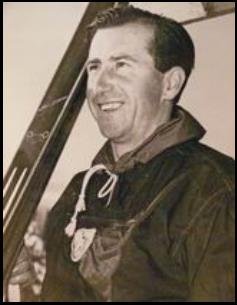
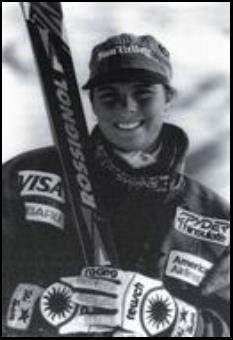
|
Pravda |
|
Street |

|
Corrock |
|
It was also on the slope of Sun Valley that the divisions between the sports of Alpine Skiing (riding a lift up a slope to ski down) and Alpine Touring (walking or skiing up a slope to ski down) transpired. Prior to 1936 and the invention of the chair-lift, nearly all downhill skiing was accomplished with Alpine Touring techniques. As chair-lifts were constructed on Proctor and Dollar Mountains in 1936 and on Bald Mountain in 1939, the sport of Alpine Touring began its rapid decline while Alpine Skiing soon became the primary means to accomplish a downhill run on skis. Sun Valley’s Ski School accommodated this unique occurrence in Alpine Skiing History, not as a follower but as a leader by changing its curriculums towards American in patients of learning to ski in the shortest time possible. While prior to 1952, Sun Valley Company hosted both disciplines with separate Alpine Skiing and Alpine Touring Schools, the technological advancements in uphill transportation soon won the day as Sun Valley officials discontinued the Alpine Touring School by the mid-1950s. |
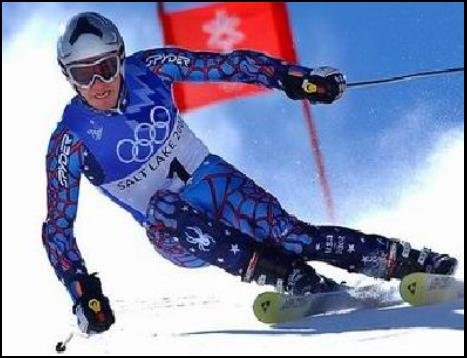
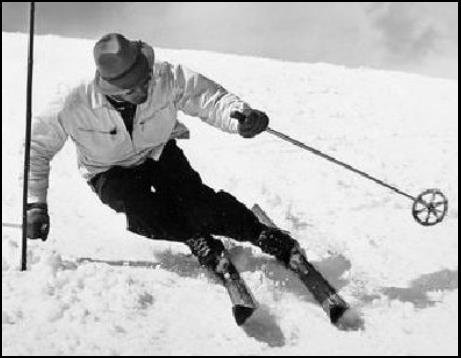
|
While technical advancements in equipment and slope grooming have changed and improved considerably throughout the years, the biomechanical makeup of the human body has not. As a result, such fundamental aspects relating to the human body’s balance while standing on a pair of skies has changed little. |


|
As Sun Valley’s limelight in the history books may have occurred as circumstances of an era, as some might argue, exposed within the soles of its pioneering founders, an everlasting mountain endeared resourcefulness ensued which transcended these historic times in a uniqueness found only in Sun Valley. |
|
Copyright ©IDAHOOUTDOOR.NET All Rights Reserved. |


|
THE WORLD HISTORY OF ALPINE SKIING—A SUN VALLEY IDAHO STORY |

|
BY BASIL SERVICE |
|
The world professional racing circuit also found its inceptions on the slopes of Aspen under Pfeifer’s able guidance and procurements of the world’s greatest skiers. The International Professional Ski Racers Association (IPSRA) held its debut race on Aspen’s Buttermilk Mountain in 1961 with talents such as double-Olympic –medal winner Toni Spiss, World Champion Anderl Molterer and Olympic Gold medalist Stein Eriksen. However, it was Sun Valley’s 34-year-old Christian Pravda who took the purse for the slalom. The following season the slopes of Sun Valley hosted the world’s first televised version of Professional Ski Racing. The “IPSRA” continued till the 1967-68 ski year where it finally folded; however its short existence managed to create the professional ski racer and pave the way for additional pro ski racing organizations such as the World Cup in 1966. |
|
Sun Valley’s Fred Iselin assumed the position of Ski School Director at Buttermilk while Stein Eriksen procured the principle head of the Highland’s following his Sun Valley exit. Alix Cushing, a Harvard Law School graduate developed a new resort in the Sierra’s of Northern California. Squaw Valley opened for business in 1949 with one double chairlift, a rope tow, and a fifty-five room lodge. Freshly departed from the Slops of Sun Valley, Emile Allais procured the head of their ski school. In February of 1960, over 800 athletes and 30 national teams competed in the VIII Olympic Winter Games and FIS World Championships at Squaw Valley. The first televised Olympics, and the first games to hold alpine skiing events in the states, the 1960 games brought international publicity to the Lake Tahoe region and re-sparked interest in the French and their reincarnated alpine racing program. |
|
Dominating the alpine events at Squaw, French racers such as Jean Vuarnet, Guy Périllat, and Charles Bozon began turning heads towards yet another new way to ski. Vuarnet became the first downhill racer to win gold on non-wooden metal Emile Allais designed skies. Vuarnet teamed with his coach Georges Joubert, a French ski trainer and the most prolific author of ski technique books and articles who ever lived, to publish "How to Ski the New French Way" in 1960. In 1967, this book was translated into English and published in the United States where some ski schools began using these techniques with their curriculums. Joubert was the Director of alpine skiing at the University of Grenoble where he headed the world’s largest ski school through the Grenoble University Club. Joubert applied the word “avalement,” meaning swallowing, to a technique he claimed alpine skiers used to win races. The French furthered their new found prosperities in the 1964 Olympics in Innsbruck, Austria winning seven of the twenty-three alpine medals awarded. However taking a disappointing 5th place in the men’s giant slalom, a race he was heavily favored to win, a young Jean-Claude Killy from Val-d'Isere France began his move into the annals of alpine ski history sponsoring yet another French assault on Austria’s skiing dominance. |
|
Killy, using techniques Joubert describes in many of his writings, became the first World Cup champion in 1967, winning 12 of 17 racing titles. A feat, in all probability, that will never be equaled by the specialized World Cup Racers of today. Killy amazingly also won the season titles in each of the three disciplines of Slalom, Giant Slalom, and Downhill by winning all five downhill races, and four of the five giant slalom races; again an achievement that likely will never be equaled. But, it was the 1968 Winter Olympic Games in Grenoble, that France truly showed the dominance of the French alpine skier. (The Grenoble Games would see no alpine skiing medals won by American Racers). That year, Killy won the Triple Crown of Alpine Skiing, repeating what some felt could never be accomplished again. Mimicking Toni Sailer’s triumphs of the Downhill, Giant Slalom and Slalom Events in the 1956 Cortina Winter Games, Killy accomplished the impossible. However, said sweep was not without controversy and of course, it involved an Austrian. |
|
Karl Schranz was born in Hannes Schneider’s St. Anton, Austria and in the 60s thru the early 70s, was one of alpine skiing’s greatest competitors accomplishing one Olympic medal and five World Championship Emblems. In 1965, he dominated Sun Valley’s Harriman Cup taking all events. In the 1968 Grenoble games, Schranz posted the fastest time with his first run in the slalom and was forced to repeat his second run when a race official stepped on the course. With the subsequent third run almost as successful as the first, Schranz finished first overall and was slated to receive his first Olympic gold. This, however never transpired as a second race official claimed he missed a gate on his second run. This assertion sparked many disagreements as Killy had already won gold in the downhill and giant slalom and was currently scheduled to receive silver in the slalom. In a 3-2 jury decision, Schranz was disqualified, giving the gold to Killy and the sweep. To this day, many carry deep qualms that partisan French officials unfairly prevented Schranz from winning so Killy could repeat Toni Sailer’s 1956 triumphs. On dozens of occasions, Killy visited the slopes of Sun Valley, and according to Sun Valley publicist Dorice Taylor, he ordained it as the world’s second best, successive only to Val-d'Isere France, his hometown; possibly another partisan French opinion.
|
|
The 60’s also marked the end of an era with Sun Valley and Union Pacific’s control over the aging resort. Union Pacific discontinued rail service to Sun Valley in 1964. While Amtrak continued limited service thru the 70s with a few “Snow Ball Ski Trains,” the last train to Ketchum arrived in November 1981. By the early 1960s, Union Pacific officials consulted with members of the Janss Corporation on how to renovate and compete with their progressive competitors. Recommendations of infusions of millions didn’t bide well with Union Pacific’s Board of Directors, as they suggested an outright sale of the resort. Bill Janss and the Janss Corporation purchased Sun Valley in 1964 and acquired full control of the resort by 1968. |
|
Janss was an idea man, and he embarked on a developmental pilgrimage that would once again place Sun Valley at the forefront of the world’s most outstanding ski resorts. Janss initially did this with an ambitious plan of further developing the slopes of Bald Mountain. By more than doubling the number of ski trails and lifts and by developing both the Warm Springs and Seattle Ridge sides of the mountain, Baldy, once again became arguably the best ski mountain in the world. To pay for his Bald Mountain enhancements, condominium and home developments increased significantly as well. |
|
While Sun Valley’s advancements to Bald Mountain forged forward, new developments in boot and ski designs as well as the world’s infatuations with the skiing genius of France’s Jean-Claude Killy once again changed the way the world would ski. Plastic boots as well as fiberglass composite skies also allowed greater support as well as maneuverability to those who ventured in the moguls, giving rise to “avalement” innovators who hastily made their homes in Sun Valley. With the increased crowds and technical advancements in ski, binding and boot designs, moguls on the world’s ski slopes grew to enormous proportions. The slopes on Sun Valley’s Bald Mountain quickly garnered a reputation of encompassing the globe’s most demanding mogul fields. Ski runs such as Exhibition, Holiday and Limelight fashioned a new breed of skier who pioneered new styles, techniques and freedoms contrary to the restricted regiments of the alpine ski racer. One such skier was Sun Valley’s Bob Burns who is widely credited with the nobility of being the world’s first “freestyle skier.” Ski Movie Producer Dick Barrymore first saw Burns skiing down a run on Sun Valley’s Bald Mountain called Lower Holiday in 1969. This vision of Burns’ freestyle nature changed his life as a ski filmmaker. |
|
Burns as well as Sun Valley skiers Jim Stelling, George King, Bob Griswold, Bob Hamilton, and Pat Bauman gained instant celebrity in Barrymore’s films as the new sport of “freestyle Skiing” found its initial beginnings on the slopes of Bald Mountain. Soon organized freestyle skiing competitions erupted throughout the United States which started in the moguls and eventually broadened to the sky with “Aerial” and “half-pipe” competitions. Mogul contests on Sun Valley’s Exhibition as well as the 1975 World Freestyle Championships in Snow Bird Utah gave rise to talents such as John Clendenin, Wayne Wong and Sun Valley mogul champions Eddie Ferguson, Dino Dudunakus and Scott Hanson. Additional equipment changes such as shorter fatter skies and higher boot tops also ensued in the mid to late 1970s. (Ski lengths would go long again in the 1980s only to shorten by the mid-1990s to today’s parabolic designs). |
|
In this era of Joubert’s “avalement”, Killy’s “Celebrity” and Bob Burns’s “freestyle skiing,” Sun Valley’s Austrian dominated ski school still held onto the sound fundamental teaching principles of its Austrian heritage with some minor twists. Sigi Engl, Sun Valley’s Ski School Director at the time, seeing the popularities of the “freestyle skier” long before it was admired, hired Burns and Griswold as instructors. Engl along with his assistant director, Sep Froehlich, often scoured the globe for the world’s best skiers as they did at the first Interski Congress held outside the European Continent. (INTERSKI had its beginning in Zurs, Arlberg of Austria, in 1951. Representatives of the European alpine nations met to share information on technique and ski teaching methodology.
The first country outside of Europe to host an INTERSKI Congress was the USA. This Congress was held in Aspen, Colorado in 1968) |
|
Traveling to Aspen, Colorado, Sigi and Sep saw the world’s greatest skiers demonstrate their country’s versions of the alpine ski turn. Austria’s team was again ahead of the curve as their demonstrations showed a little space between the legs and skies. This technique was contrary to the popular reverse shoulder, skies close together, wedeling of the day and provided a more functional balanced stance. Sigi paid close attention to a skier from his hometown of Kitzbuhel, who seemed to show an extraordinary talent. Rainer Kolb was born in 1939, during the onset of the Second World War, to a German Father and Austrian Mother in the region of South-east Germany known as Bavaria. Being the oldest of three kids, Rainer, his mother and two siblings lost their Bavarian home in 1944 to Allied bombing forcing an exodus to the relative safety of the snow-covered Alps of St. Anton to live with an Aunt. Rainer’s father served with the German army and in 1945 died in a French Concentration Camp causing the family to move yet again. Staying in St. Anton for less than a year, the Kolb’s then moved to Kitzbuhel, Austria, staying with another Aunt who had a Mountain Restaurant and inn (Hostel). As chance may have it, these accommodations sat at the top of Kitzbuhel’s, Hahnenkamm Downhill Ski Race. (The Hahnenkamm was first run in 1931 and is known as the world’s most prestigious as well as demanding downhill) |
|
Rainer’s skiing skills evolved quickly as he and several of his friends made winter dashes down the Hahnenkamm to school. While the participants in this morning schuss were mostly of the male persuasion, one little girl by the name of Christl Haas dared to challenge the boys. Racing Rainer, his male friends and the Arial Tram down the Hahnenkamm every winter morning, Haas soon became the world’s best with Olympic medals in the 1964 and 1968 Winter Olympic Games and Four Downhill World Cup Championships. (Haas would not be alone as the slopes of Kitzbuhel would produce more Alpine Skiing Olympic medals than any other town in the world with champions such as Toni Sailer, Hinterseer Ernst, Hias Leitner, Anderl Molterer and Sun Valley’s Sigi Engl and Christian Pravda). By the age of 16 Rainer was the Kitzbuhel Area Junior Champion for two years running which gained him a position with the prestigious Junior Austrian Tyrolean Ski Team where he specialized in Giant Slalom. In 1958 at the age of 18, Rainer was invited to ski in the Hahnenkamm Downhill but placed disappointingly subsequent in a very talented field of competitors. |
|
While his racing talents were tremendous they yielded few first place finishes against Austrian racers who dominated the ski world in the late 1950s and early 1960s. As a result, Rainer turned his energies towards studying and quickly acquired educations in Ski Instruction and pharmacy. Acquiring his Austrian Full Ski Certification in 1963 with the highest marks ever acquired, Rainer’s talents even caught the eye of Stefan Kruckenhauser, Professor of Biology and Sport at the University of Innsbruck. Kruckenhauser invited Rainer to certify Austrian Instructors at St Christoph in the Arlberg of Austria and in 1967 when the Japanese choose the “Austrian Ski System” for their teaching curriculum, Rainer along with Professor Kruckenhauser traveled to Japan to help with their inceptions. In 1964 Rainer was chosen as one of eight of Austria’s most elite skiers to represent his country at the interski allowing him to make his first sojourn to the United States and the Ski Slopes of Aspen, Colorado in 1968. While in Aspen, Rainer’s talents caught the eye Aspen’s ski school director who offered him a job. As chance may have it, Sun Valley ski legends Sigi Engl and Sep Froehlich were also in attendance and wasted no time offering Rainer a position as well. Accepting the Sun Valley position on the ski school, Rainer, his son and wife moved to Idaho. Rainer’s wife, being from Spokane, Washington, knew Sun Valley well as she worked for the resort one prior winter. |
|
As Sun Valley headed into the early 1970s Bill Janss (Sun Valley’s Owner) had some pressing concerns with the ski school. Having an Austrian dominated school in an era dominated by the French and the teaching concepts of Joubert, Vuarnet and Killy, Janss felt a different direction for the school was necessary. This coupled with Sun Valley’s nearly two-decade drought of acquiring any Olympic Medals furthered Janss’ concerns. Janss, on several occasions, sent Paul Ramlaw, one of Sun Valley’s lead instructors, to the newly developed Vail, Colorado to learn of their success in drawing customers. In 1972, the decision was made to replace Sun Valley’s legendary Sigi Engl with its second non-Austrian director as Paul Ramlaw accepted the position. |
|
Paul Ramlaw grew up in Ballston Lake, New Youk and joined the Sun Valley Ski School in 1953 under the able direction of Sigi Engl, Sepp Froehlich, Les Outzs and Bill Butterfield. According to former Sun Valley Ski School Director Rainer Kolb, Ramlaw was an incredibly nice person to deal with as well as an amazingly technically oriented skier. Ramlaw’s direction for the ski school very much followed Joubert’s principles of avalement (bend stretch skiing). Joubert applied the word avalement, meaning swallowing, to a minor technique which, he claimed, three-time gold medalist Jean-Claude Killy and others were using to win races. He showed how a skier can keep the head and upper body moving in a smooth line downhill through the bumps, swallowing the terrain irregularities by allowing the knees to fold and unfold like an accordion. Ramlaw’s technical expertise was also admired by magazine publishers in Ski and Skiing magazine where several of his articles were published. Ramlaw also took the ski school in the direction of resorts such as Vail, Colorado, hiring many instructors to accommodate Sun Valley’s increasing base of clients, as well as implementing strict uniform practices. |
|
While some ski schools members believed in the “New French Way” to ski, the majority of Sun Valley’s top instructors felt different. While the principles of avalement had its place in teaching on minor occasions for mostly the advanced skier, it gave little for the beginner and novice. With most advanced skiers, the bend stretch precepts of the “French Technique” were difficult to understand and apply. This coupled with the rapid decline of the French racer in the 1972 Winter Olympic Games; saw Janss looking towards yet another direction for the school in early 1974. Initially wanting a fresh start for the school by hiring an outsider, Janss soon realized that some of the world’s greatest skiing talents lay within. One such standout was Professor Kruckenhauser phenomenon, Rainer Kolb. Kolb became a stickler on teaching styles greatly curtailing the “bend stretch” “Avalement” techniques of the short-lived Ramlaw era. While “Avalement” was still part of the schools curriculums, it was only taught on a limited basis under the right conditions and in the right places. Initially for his supervisors, Kolb secured the services of Austrians’ Arnold Konrad and Sep Frohleich with Bill Butterfield as the lone American delegate. Kolb would later add Don Reinhart, who along with Bill Lash and Horst Abrhams tilled the initial beings of the “Professional Ski Instructors of America” (PSIA), which, to date trains the bulk of America’s ski teachers. Sun Valley’s school during the Kolb years excelled with its “PSIA” accomplishments placing two of its members on the National Demonstration Team with Nancy Oaks and Greg Moss. A feat never to be repeated with Sun Valley’s subsequent directors. |
|
Kolb’s 25 years as Sun Valley’s Ski School Director transcended a period in Alpine Skiing that would also see the American racer reach the pinnacle of his/her existence. As it did in year’s past, Sun Valley racers, as well as its ski school played a pivotal role in this success. Hosting World Cup events in 1975 and again in 1977, the slopes of Bald Mountain, as it had in its Harriman Cup years, again played host to the world’s most accomplished racers. Italy’s Gustavo Thoeni, Sweden’s Ingemar Stenmark and the United States’ Steve Mahre dominated the events. |
|
In the 1976 Winter Games in Innsbruck, Austria and the 1980 Games in Lake Placid, New York, America ski racers began a period of unprecedented triumphs. Phil and Steve Mahre from Yakama, Washington, Andy Mill from Aspen, Colorado, Cindy Nelson, from Lutsen, Michigan, the brother and sister team of Pete and Suzie Patterson, from Sun Valley, Idaho as well as the step-daughter of Bill Janss from Sun Valley, Christine Cooper, all gleaned admirable accomplishments in said games. However, it was the 1984 games in Sarajevo, Yugoslavia where the American racer dominated the alpine events for the first time. This American dominance would not be repeated again till the 2010 games in Vancouver, Canada. |
|
Being the home province of Sun Valley’s Otto Lang, Sarajevo holds the distinction of being the first winter games held in a socialist country. Winning more alpine skiing medals than any other country, American racers truly took over. In the Men’s events, the twin brother team of Phil and Steve Mehre as well as Bill Johnson, from Mt Hood, Oregon triumphed two gold and one silver. On the woman’s side, Debbie Armstrong from Salem, Oregon as well as Sun Valley’s Christian Cooper added to an American confiscation of emblems. Tammera McKinney, from Squaw Valley, California narrowly missed an American sweep of the woman’s Giant Slalom, after being squeezed into the fourth position by France’s Perrine Pelen. The late 70’s would again see ski resorts across the world develop at an unprecedented pace, as Sun Valley again observed their infrastructure of lodges and ski lifts lag far behind newer resorts such as Vail, Colorado, Deer Valley, Utah and Whistler, British Columbia. Without the necessary infusions of cash to compete on such a grand scale, Bill Janss contemplated a sale of his Sun Valley. Initially negotiating with Walt Disney Corporation, Sinclair Oil Corporation, and his owner, Earl Holding successfully acquire the historic resort in 1977 for the sum of $12,000,000.00 after reading about its availability in the Wall Street Journal. With Holding’s “hands on” style of management, infusions of the necessary cash transpired on a grand scale with vast improvements to nearly all of Sun Valley’s frameworks. Grand lodges, tremendously improved Chairlifts and state of the art snowmaking propelled Sun Valley to the number one position of North American Ski Resorts on Ski Magazine’s reader’s poll. To date, Forbes Magazine estimates the value of the resort to be $300,000,000.00 Dollars. As far as the Ski School was concerned, Holding took an opposite approach, allowing Kolb to attend to matters with little intervention. |
|
As US Ski Team Members and local ski team coaches Ken Corrock and Terry Palmer joined the ranks of the Ski School, Sun Valley ski racers acquired even more Olympic hardware in the 1994 and 1998 Olympic Games when Picabo Street secured silver and gold. However, it was the Winter Games of 2002 in Salt Lake City, Utah that truly brought the flavor of the Olympics closest to its slopes. While Sun Valley hosted no Olympic venues for the games, its facilities were used by many of the world’s alpine and Nordic ski teams for training purposes. Sun Valley’s sister resort of Snow Basin, Utah, also owned by Earl Holding, hosted the downhill, super-G and combined events. Switzerland’s downhill skiing champion Bernhard Russi, at the requests of Earl Holding and Rainer Kolb, designed the slopes of Snow Basin for the Downhill competitions. Dominating the alpine events in said games, Austrians who acquired 9 of the 30 medals awarded. The lone American Alpine skier to appropriate any medals from the 2002 Winter Olympic Games was Bode Miller from Easton, New Hampshire. |


























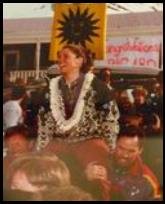
|
Iselin |
|
Allais |
|
Joubert |
|
Killy |
|
Schranz |
|
Janss |
|
Janss |
|
Burns |
|
Jim Stelling, George King, Bob Griswold, Bob Hamilton, and Pat Bauman |
|
Froehlich |
|
Kolb |
|
Christl Haas |
|
Right Toni Sailer, Hinterseer Ernst, Hias Leitner, Anderl Molterer Christian Pravda |
|
Ramlaw |
|
Kolb |
|
Lash |
|
Pattersons |
|
Cooper |
|
Mahre |
|
Street |
|
Corrock |
|
Palmer |

|
Holding |